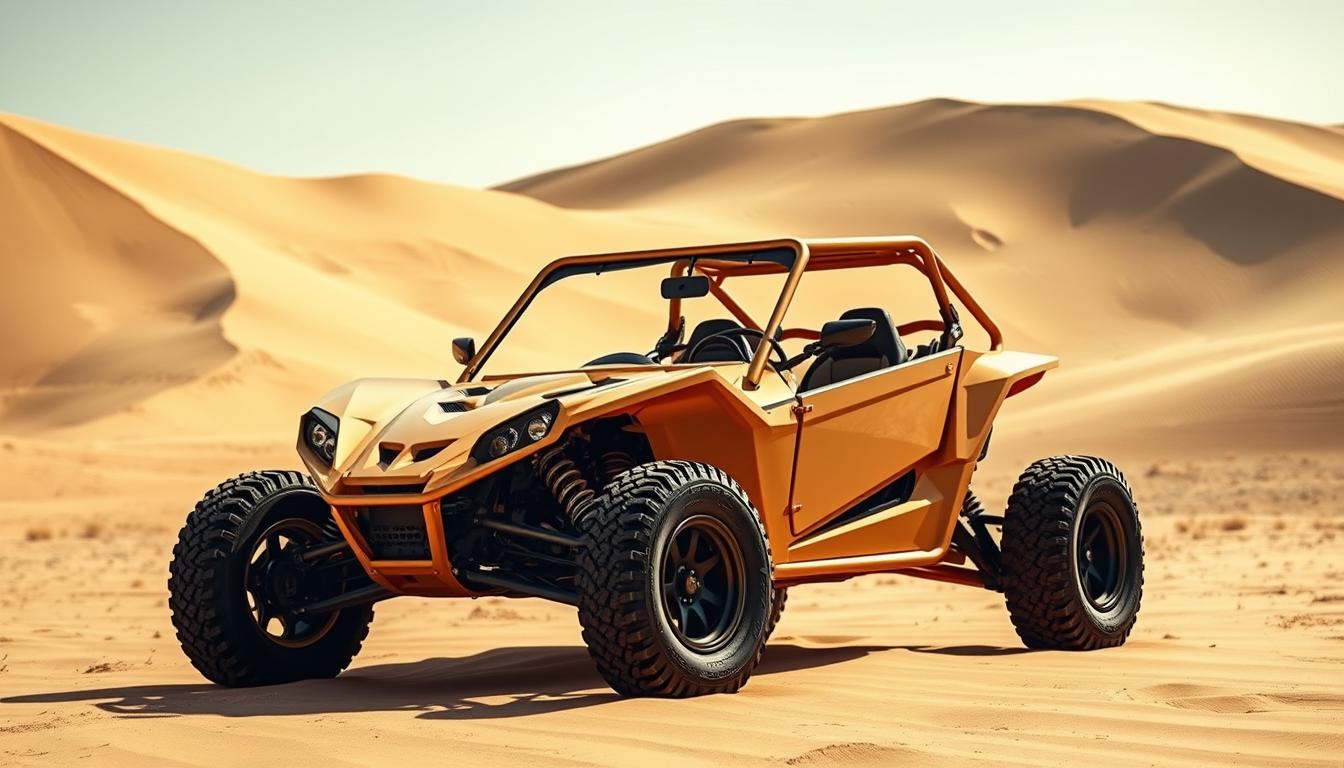
- 85 Views
- 19 Min Read
- (0) Comment
Picture yourself starting your quad bike, with excitement pumping through your veins. You’re about to explore the UAE’s dunes. The sunlight spills over the desert, making every moment picture-perfect. With your camera by your side, you’re set to capture the thrill and beauty of this adventure. Our tips will make your photos stand out as you ride with Desert Buggy Rental Dubai. No matter if you’re a pro or new to photography, snapping pictures of quad biking is an epic mix of fun and creativity.
Learning to capture the desert’s spirit, getting the perfect frame, and catching the joy of each moment—these will be your new skills. Our guide will show you how to make every photo of your UAE desert trip tell a vivid story of excitement and splendor. So, put on your helmet, grab your camera, and join us in the world of quad biking photography.
Key Takeaways
- Understand how off-road photography tips can enhance your quad biking experience.
- Discover the joy of capturing quad biking moments and bring your UAE desert adventure photography to life.
- Find out how Desert Buggy Rental Dubai can facilitate your ultimate photography excursion.
- Learn to choose the right photographic gear to withstand the rugged desert environment.
- Receive practical advice on composing shots that fully encapsulate the thrill of quad biking.
Introduction to Quad Biking and Photography
Taking off on a quad bike adventure is exciting and gives you chances to take amazing photos. The untouched, wild sceneries available to quad bikers make for a perfect backdrop for off-road photography. This guide shows why combining quad biking and photography creates stunning pictures. It also explains how learning the basics of off-road photography can make you a better photographer.
Why Quad Biking Offers Unique Photographic Opportunities
For photographers, quad biking is special because it lets you go places most people can’t. Think wide-open deserts and challenging mountain paths. These places offer unique photographic opportunities beyond what regular tourist spots can. The excitement of riding a quad, with all the dust, mud, and splashes of water, makes for lively and moving photos.
Understanding the Basics of Off-Road Photography
Quad biking is thrilling, but capturing that excitement in photos takes skill. You need to know how to handle changing lights, moving targets, and rough grounds. This part offers tips and insights for dealing with these off-road photography challenges. Here, you’ll find the quad biking photography tips you need to face off-road photography head-on.
Embrace the challenge of capturing the untamed beauty and fleeting moments offered by off-road environments, harnessing skills that will define your photographs as uniquely powerful.
Choosing Your Off-Road Photography Gear
When you ride your quad bike into the wild, having the right photography gear matters. It’s not just about getting great pictures. You also need to protect your gear from tough places. Picking the right tools for quad biking photography makes your adventure even better.
Selecting the Right Camera for Quad Biking Photography
Choose a camera that’s tough and works well for your needs. Action cameras like GoPros are great for rough rides. They’re tough and can handle bad weather. For higher-quality photos, think about DSLRs or mirrorless cameras. They’re good at taking clear pictures quickly and in low light.
Essential Accessories for Off-Road Photography
Having the right accessories helps you take amazing photos, even when it’s hard. UV filters keep your lens safe from dust and scratches. Polarizers make the sky and ground look better. Make sure your quad biking photography equipment is safe in a well-padded bag. Sturdy tripods let you take clear pictures on uneven ground.
- Shock-resistant camera cases
- High-capacity memory cards
- Extra batteries for cold weather and long adventures
Good planning and the right gear make your quad biking photo shoots successful. Every rough spot on your ride can add something special to your photos.
Off-Road Photography Tips for Quad Biking Enthusiasts
Exploring the dynamic art of quad bike photography advice requires adapting. You must handle the unpredictable desert and the fast pace of quad biking. Having stable equipment, making quick adjustments, and eyeing the perfect moment are key for these thrilling shots.
Begin by readying for action. The desert offers a vast, dramatic scene. Yet, it’s the surprising moves of quad bikes that create heart-stopping photos. Learn off-road photography techniques suited for action. Adjust your shutter speed to capture the motion clearly or blur it for effect.
Keeping your camera stable is crucial. Without stability, clear shots are hard to get. Using a strong monopod can help. It gives you the support needed in the busy world of off-road photography, without the hassle of a tripod.
Also, quick setting changes are vital in off-road photography techniques. The desert’s changing lights and scenes mean you must switch settings fast. This skill lets you make the most of your time and increases your odds of capturing the perfect quad biking moments.
By mastering these abilities and regularly using these tips, you are on your way. You’ll capture amazing, lively photos that show the thrill of quad biking.
Mastering Quad Biking Photography Composition
Capturing the thrill of quad biking starts with knowing basic photography composition. This knowledge will turn your photos from okay to wow. We’ll cover key composition techniques to make your quad biking photos look pro. You’ll learn about the rule of thirds, leading lines, and unique angles to enhance your photo narratives.
Good composition does more than just show a subject. It draws in the viewer and guides their attention across the image. This is crucial in quad biking photos. You want to balance the sport’s action with the beauty around it.
The rule of thirds adds structure and excitement to your images. It makes your main subject more dynamic.
Leading lines add depth and guide eyes through the scene, especially in quad biking’s rugged settings. This method enhances the feeling of speed and excitement inherent to the sport.
| Technique | Application in Quad Biking Photography | Visual Impact |
|---|---|---|
| Rule of Thirds | Place the bike or rider at an intersection point for better engagement. | Makes the subject stand out and balances the elements around it. |
| Leading Lines | Use paths or the bike’s angle to guide the viewer through the photo. | Draws the viewer’s eye, adding depth and movement to the photo. |
| Varying Perspectives | Try different angles, like low shots or aerial views, to show landscapes. | Brings a fresh perspective and enhances the photo’s story. |
Using these techniques will improve your photos’ composition. Your photos will tell exciting stories of adventure, action, and nature. With these tips, your off-road photo collection will grow in quality and impact.
Capturing Quad Biking Moments
Going on a quad biking adventure is exciting and worth capturing well. It’s tricky to catch these moments because you need good timing and unique angles to show the fun and beauty of riding off-road. This section will teach you how to ace your action shot timing and find cool angles for amazing photos.
Timing Your Shots: Action and Stills
When taking pictures of fast-moving subjects like quad bikes, timing is everything. You have to predict the action before it happens. This means knowing the track well, spotting where the cool moves are likely to be, and being ready to capture them. Catching a high-speed jump or a sharp turn needs quick thinking and fast actions, making your photos stand out.
Finding Unique Angles for Your Photos
Looking for new angles can really change how your quad biking pics look. Try shooting from low down for a dramatic view of the bike on tough terrain, or go high to show off the great outdoors around the rider. Photos from the side can also look awesome, especially if the bike is moving fast. Each angle shows a different side of the adventure and highlights various parts of the action.
- Low-angle shots: Show how big and wild the area around the quad bike is.
- High-angle shots: Capture the path of the rider and the beauty of the trail.
- Dynamic side angles: Focus on the bike’s speed and smooth movements.
Using these tips will help you take breathtaking quad biking photos. They show the thrill and excitement of the ride. Great pictures come from the photographer’s skill in catching the right moment and being creative with angles.
Off-Road Photography Lighting Tips
Perfecting your off-road photography lighting tips can make your quad biking adventures stunning. It’s all about knowing how to work with natural light and flash outdoors. These skills are key for great photos.
When you’re taking photos off-road, it’s important to know how natural light works. In the early morning or late afternoon, sunlight is soft and warm. This light makes landscapes and people look great. But, midday light can be tough. It’s strong and creates sharp shadows but can make your photos dramatic.
In natural light photography, adapting to changing light is vital. Using the beautiful light at sunrise and sunset can turn your photos into amazing stories.
Using a flash off-road has its benefits, even in daylight. It can light up shadows, like under helmets or in bike parts where sunlight doesn’t reach. Reflectors are also helpful. They soften shadows and bring out details you might not see otherwise.
Controlling your lighting can make a big difference in your off-road photos. Here’s a quick guide on using light at different times of the day to make your photos pop:
| Time of Day | Lighting Condition | Suggested Technique |
|---|---|---|
| Early Morning | Soft, golden light | Maximize ambient light; minimal flash |
| Midday | Bright and harsh | Use flash to fill shadows |
| Late Afternoon | Warm, softening light | Enhance with reflectors |
| Evening | Low light | Primary use of flash and additional lighting gear |
With these tips, you’re ready to take amazing off-road photos. Whether you use natural light or flash, your photos will tell the story of your adventures.
Quad Biking Photography Ideas to Inspire You
Capture the essence of adventure with these quad biking photo ideas. They blend thrill with art. Off-road photography lets you document the adventure and try new creative methods. These can make your photos tell a more compelling story.
Start by documenting quad biking from beginning to end. You’ll capture not just the journey, but the entire experience. From getting ready to the post-ride reflection. This makes viewers feel the excitement too.
Try creative photography approaches. Use environmental portraits or play with scale and perspective. This shows the intensity and beauty of the surroundings. It connects with viewers on an emotional level.
| Idea | Description | Visual Impact |
|---|---|---|
| Dynamic Action Shots | Freeze motion to showcase quad biking’s power and speed in high-speed moments. | High |
| Environmental Portraits | Highlight the rider in the vast landscapes, showing the bond with nature. | Medium |
| Macro Details | Display close-up shots of gear, mud on tires, or trail texture. | Medium |
| Biker’s Perspective | Give a first-person view with helmet cams or handlebar cameras. | High |
| Dusk and Dawn Rides | Show early morning or late evening rides in natural light. | High |
Mix quad biking photography ideas into your story. You’ll not just keep memories but turn them into engaging art. Every detail, from landscape blur to a glove’s stitching, tells a story beyond words.
Let these tips inspire unique approaches for your next outdoor photo adventure. Remember, the best shots come from daring to push limits and embracing the challenges of dynamic, off-road photography.
Improving Your Off-Road Photography Techniques
Pushing your photographic skill advancement in off-road adventures means going beyond normal photography. This lets you capture the lively nature of quad biking. Mastering off-road photography techniques isn’t just about managing your camera outdoors. It’s also about turning every photo into a vivid story.
To really make your quad biking photos stand out, look at how light and shadow play together. This happens as the sun moves over the rough landscapes. Using a high-speed shutter setting is key. It freezes motion, getting every bit of dirt in clear detail as bikes speed down the paths.
- Experiment with different angles to show the intensity and excitement of the ride.
- Use burst mode to get a series of actions, telling a whole story from beginning to end.
- Look at how dust and sand move against the light, as it can make your photos more dramatic.
Each tip is about enhancing quad biking photos by turning an adventure into an exciting art form. The power of off-road photography techniques is showing the rough beauty of nature and the thrill of quad biking. As you work on your photographic skill advancement, see every trip as a chance to improve your skills and push your creativity further.
Editing Your Quad Biking Photos for Maximum Impact
Learning to edit quad biking photos well can really make your pictures pop. If you want to show off the rough ground, the excitement of the ride, or tell a story, knowing how to enhance your photos is key.
To start with basic photo enhancement, focus on fixing lighting and color. Making the contrast, brightness, and sharpness better will make your adventure look clearer and more inviting. This makes your photos look better and helps everything in them stand out.
Advanced editing techniques take your photo skills further. You can try color grading, putting layers together, and fixing details digitally to look more professional. Adjusting the sky’s color or mixing different shots for the right motion and sharpness can change your photos’ story.
Learning both basic and advanced editing is essential for standout quad biking photographs. With these editing steps, your photos won’t just record moments. They will burst with life and emotion, catching the eye of anyone who sees them.
Improve your editing to make your quad biking memories more than just images. Enhancing your skills makes every picture tell a deeper story, draw more looks, and leave a stronger memory.
Protecting Your Camera Equipment Off-Road
Riding quad bikes across rough terrains offers exciting moments and chances to snap unique photos. But, the tough conditions of off-road places like deserts can harm sensitive camera equipment. Knowing how to keep your gear safe will avoid damage off-road and keep your photography tools in good shape.
Preventing Damage in Rough Conditions
Start by preparing your camera for the adventure. Sandy and dusty areas off-road can get inside camera bodies and lenses, causing damage. Use protective covers and top-quality camera bags with sealed compartments to protect them. Also, place your gear back in these cases when you’re not using it.
Maintaining Your Gear After Dusty Rides
Cleaning and storing your camera gear right after an off-road trip is crucial. If dust and sand stay on your camera, they can harm it over time. Use a soft brush or air blower to clean the body and a microfiber cloth for the lens. It’s best to do this cleaning in a clean place to avoid more dust.
| Cleaning Tool | Purpose |
|---|---|
| Air Blower | Removes external debris without contact |
| Soft Brush | Gently cleans hard to reach areas |
| Microfiber Cloth | Polishes lens without scratching |
| Lens Cleaning Liquid | Removes smudges and fingerprints |
Taking the time to care for your camera and accessories not only prevents damage off-road, but also keeps your gear ready for more adventures. By sticking to these tips, your equipment will stay in top shape for your next outdoor journey.
Sharing and Showcasing Your Quad Biking Photography
Sharing the excitement of off-road adventures is key. Use social media and a photography portfolio to increase your visibility. This way, you can share your best images and connect with those who love quad biking.
Social Media Strategies for Photographers
Choose social media platforms favored by outdoor and photography fans. Share your photos on Instagram and Facebook. Use #QuadBikingPhotography to reach more people. Posting regularly and sharing stories about your adventures will make your profile more visible.
Interact with your followers by replying to comments and sharing content with your photos. Collaborating with others in your field to share each other’s work can help you reach more people.
Creating a Portfolio of Your Best Work
Your photography portfolio is like your own professional gallery. Make it easy to use, good-looking, and true to your style. Pick photos that tell a story or highlight the best parts of your adventures.
A well-made portfolio not only shows off your skills but also helps you find new clients or partners. Make sure each photo is high-quality and correctly tagged to show up in searches, helping more people find your work.
Here’s a helpful table to guide you in setting up your online portfolio:
| Feature | Description | Impact |
|---|---|---|
| User-friendly interface | Easy navigation and clean layout | Enhances visitor engagement |
| High-quality images | Best resolution and professionally edited | Shows professionalism and skill |
| SEO optimization | Proper use of tags and metadata | Improves visibility on search engines |
| Mobile compatibility | Accessible on various devices | Expands audience reach |
Commit to these sharing strategies for your quad biking photos. Start by choosing your best shots. Then, plan your social media or portfolio to highlight your photography journey. This will impress and attract more viewers than ever before.
Learning from the Experts: Off-Road Photography Workshops
If you love capturing the wild outdoors, off-road photography workshops can really boost your skills. These sessions offer hands-on learning with pros. They also put you right in the middle of challenging environments to practice your photography.
Learning from experts is super valuable. They share tips that come from many years of snapping photos. Workshops often happen in stunning yet tough places like the UAE dunes. These spots are perfect for improving your photography.
Benefits of Joining a Photography Workshop
Joining off-road photography workshops lets you learn directly from the best. Experts teach you technical skills and how to capture dynamic landscapes. With their help, you’ll feel confident and skilled in taking great photos, no matter where you are.
How to Choose the Right Workshop for You
When picking a photography workshop, think about what you need. Look at the instructor’s skills, the location, and if there’s a good mix of theory and practice. Here’s what to keep in mind:
| Criteria | Importance | Details |
|---|---|---|
| Instructor Expertise | Critical | Find trainers with lots of experience and a portfolio that matches what you want to learn. |
| Location | High | Pick places with varied landscapes that will push you to learn new techniques. |
| Curriculum | Essential | It’s important to have a balance between learning in the classroom and practicing in the field. |
Choosing the right off-road photography workshop means looking for one that’s not just fun but also teaches you a lot. It should help you master taking amazing photos, even in tough conditions.
Conclusion
We’re wrapping up our guide on enhancing off-road photography for quad biking fans. Let’s quickly review the key points to boost your visual stories. We’ve given you tips on selecting durable gear and crafting compelling images to make your adventures stand out. By mastering these tips, your photos will truly shine in capturing the thrill of the desert.
Improving your techniques and excelling in editing are key to making your photos pop. Every shot and edit gets you closer to perfectly capturing your desert adventures. In post-production, your vision turns simple photos into stories that capture the eye. For those looking to reach a professional level, Desert Buggy Rental Dubai offers endless inspiration with its stunning scenery.
This isn’t the end of your photography journey, but a milestone. Each trip and photo is a chance to grow and create something unique. With your camera ready, dive into the desert’s beauty. Share your adventures, as each adds to a tale of courage and discovery. The desert is your canvas for unmatched stories waiting to be told.
FAQ
What makes off-road photography while quad biking unique?
Capturing photos while quad biking is unique because you deal with rugged terrain. This terrain lets you take exciting action shots and beautiful landscapes. You get to tell vivid stories through your images.
What type of camera should I use for quad biking photography?
Choose a tough camera for quad biking photos. A DSLR or mirrorless camera works well. Make sure it has fast auto-focus and shutter speeds. It should also be weather-sealed to keep out dust and sand.
Are there any essential accessories for off-road photography?
Important accessories include protective cases and filters. You should also get mounts like helmet or chest harnesses. They help keep your camera steady while you’re moving.
How do I keep my camera stable when capturing photos on a moving quad bike?
Keep your camera steady by using a high shutter speed. Hold your arms close to your body or use mounts. Also, a camera with image stabilization is helpful.
How can I apply the rule of thirds to quad biking photography?
Use the rule of thirds by placing your subject off-center. Align them with the grid’s intersecting lines. This creates balanced and engaging photos.
What tips do you have for timing shots during a quad biking adventure?
Watch the riders and terrain to anticipate action. Use burst mode to take many shots fast. Capture exciting moments like jumps and turns.
How do I work with natural light when taking off-road photographs?
Shoot during the golden hours for soft light. Use midday light for dramatic shadows. Adjust exposure based on the natural light available.
How can I create a compelling narrative with my quad biking photographs?
Document the adventure’s stages, including preparation, the journey, and any celebrations. Capture riders’ emotions and interactions for a full story.
What are some advanced off-road photography techniques?
Advanced techniques include using high-speed and burst modes. Try panning for motion blur. Adjust settings quickly for exposure when moving between light and dark.
What should I focus on during post-processing of my quad biking photos?
In post-processing, adjust contrast, brightness, and sharpness. Color grade for style and crop to improve composition. Use advanced techniques like dodging and burning if you can.
How can I protect my camera from sand and dust?
Use weather-sealed cameras and lenses, and protective filters. Keep your camera in a bag when not in use. Clean your equipment well after.
What’s the best way to share and showcase my quad biking photography?
Share your photos on social media with good tags and captions. Create a portfolio on a website. Join communities of quad biking fans for more exposure.
How do I select the right off-road photography workshop?
Pick a workshop with both theory and field practice, led by experienced photographers. Make sure it teaches the skills you want to improve. It should offer real-time feedback in settings like the dunes you’ll shoot in.
Categories
- Uncategorized (4)
- Desert Buggy Rental (1,397)
- Dune buggy (4)
- Quad Bike Rental (1)
- Desert safari (1)
- Hot air ballon (2)
- dirt bike (4)
Recent Post
Tags
Adrenaline-filled Desert Tour Adrenaline-fueled Dubai experiences Adrenaline Adventures AED to PKR conversion Ajman travel tips Al Safa desert exploration ATV models ATV safari Dubai Bargain quad biking in Dubai Bedouin heritage Best desert tours in Dubai Best Quad Bike Prices Dubai Buggy Adventure Dubai Buggy Tour Experience Buggy tour operators in Dubai Buggy Tours in Dubai Desert buggy experience Desert Buggy Rentals in Dubai Desert camping experiences Desert oasis excursions Desert quad bike tours Desert safari tips Dubai desert ATV tours Dubai Off-Road Excursions Dubai Off-Road Experience Dubai Off-Road Rentals Dubai Quad Biking Packages Dubai Quad Safari Dubai Safari Excursions Dune bashing adventures Dune buggy racing experiences Dune Buggy Rental Near Bur Dubai Extreme Thrills Hatta sights and attractions Marine life adventure Off-Road Adventures Dubai Off-road buggy rental Dubai Off-road dune buggy experience Off-Road Experience Sand dunes Sandy adventures in Dubai Thrilling Desert Adventures Top quad biking spots in Dubai Traditional dhow boat Dubai UAE Off-Road Excursions



